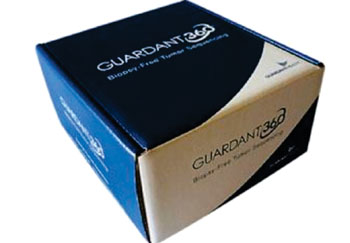Liquid Biopsy Tests Identified Cell-Free Tumor DNA Mutations
By LabMedica International staff writers
Posted on 20 Oct 2016
The feasibility of using cell-free circulating tumor DNA (ctDNA) next-generation sequencing (NGS) from liquid biopsies as a complement or alternative to tissue NGS has been evaluated.Posted on 20 Oct 2016
The expanding number of targeted therapeutics for non-small cell lung cancer (NSCLC) necessitates real-time tumor genotyping, yet tissue biopsies are difficult to perform serially and often yield inadequate DNA for NGS.

Image: The Guardant360 kit for biopsy-free tissue sequencing for cancer (Photo courtesy of Guardant Health).
Scientists at the University of Pennsylvania (Philadelphia, PA, USA; www.upenn.edu) obtained 112 plasma samples from a consecutive study of 102 prospectively enrolled patients with advanced NSCLC were subjected to ultra-deep sequencing of up to 70 genes and matched with tissue samples, when possible between February 2015 and March 2016. Only 50 patients could only provide tissue samples and liquid biopsy samples were sent to Guardant Health (Redwood City, CA; USA) for testing.
The team detected 275 alterations in 45 genes, and at least one alteration in the ctDNA for 86 of 102 patients (84%), with epidermal growth factor receptor (EGFR) variants being most common. ctDNA NGS detected 50 driver and 12 resistance mutations, and mutations in 22 additional genes for which experimental therapies, including clinical trials, are available. While ctDNA NGS was completed for 102 consecutive patients, tissue sequencing was only successful for 50 patients (49%). Actionable EGFR mutations were detected in 24 tissue and 19 ctDNA samples, yielding concordance of 79%, with a shorter time interval between tissue and blood collection associated with increased concordance. ctDNA sequencing identified eight patients harboring a resistance mutation who developed progressive disease while on targeted therapy, and for whom tissue sequencing was not possible.
The authors concluded that therapeutically targetable driver and resistance mutations can be detected by ctDNA NGS, even when tissue is unavailable, thus allowing more accurate diagnosis, improved patient management, and serial sampling to monitor disease progression and clonal evolution. Erica L Carpenter, MBA, PhD, the senior author of the study said, “The tissue biopsy sequencing result has been considered the gold standard against which one compares the ctDNA result. Our work suggests that one can act on a ctDNA result, even in the absence of the so-called gold standard, and get a clinical response in these patients,” The study was published on September 6, 2016, in the journal Clinical Cancer Research.
Related Links:
Guardant Health













